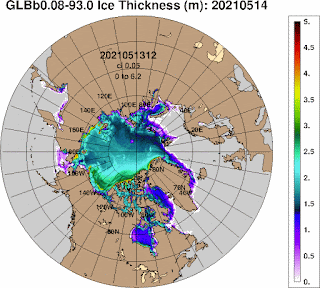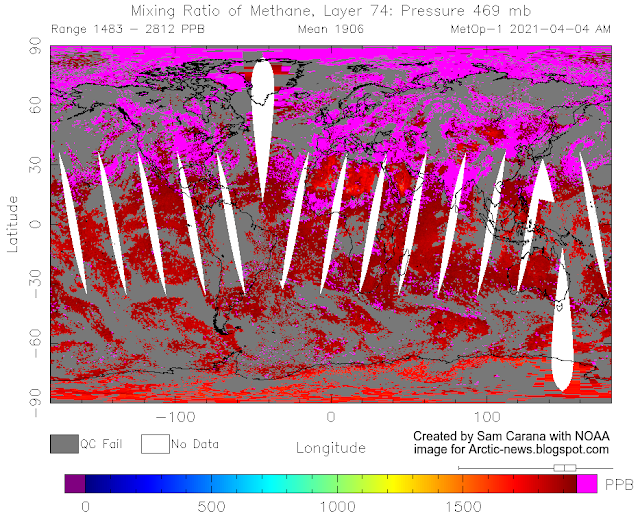At the Paris Agreement in 2015, politicians pledged to limit the global temperature rise from pre-industrial levels to 1.5°C and promised to stop rises in greenhouse gas emissions as soon as possible and to make rapid reductions in accordance with best available science, to achieve a balance between people's emissions by sources and removals by sinks of greenhouse gases in the second half of this century.
Yet, greenhouse gas levels keep rising and the rise appears to be accelerating.
Carbon Dioxide
On April 8, 2021, CO₂ levels at Mauna Loa, Hawaii, reached a level of 421.36 ppm, while several hourly averages recorded in early April were approaching 422 ppm (see earlier post).
According to NOAA, the atmospheric burden of CO₂ is now comparable to where it was during the Pliocene Climatic Optimum, between 4.1 and 4.5 million years ago, when CO₂ was close to, or above 400 ppm. During that time, the average temperature was about 4°C (7°F) higher than in pre-industrial times, and sea level was about 24 m (78 feet) higher than today.
The 2020 global annual methane (CH₄) growth rate of 15.85 ppb was the highest on record. The global CH₄ level in January 2021 was 1893.4 ppb, 20 ppb higher than the January 2020 level.
 Nitrous Oxide
Nitrous OxideThe 2020 global annual nitrous oxide (N₂O) growth rate of 1.33 ppb was the highest on record. The global N₂O level in January 2021 was 333.9 ppb, 1.4 ppb higher than the January 2020 level.
Greenhouse gas levels are accelerating, despite promises by politicians to make dramatic cuts in emissions. As it turns out, politicians have not taken the action they promised they would take.
Elements contributing to temperature rise
Next to rising greenhouse gas levels, there are further elements that can contribute to a huge temperature rise soon.
The Snowball Effect
 Temperatures are rising and they are rising at accelerating pace, especially in the Arctic. A strong El Niño and a distortion in the jet stream could cause the latent heat and methane hydrates tipping points to be crossed soon, causing many feedbacks to kick in with ever greater ferocity, and pushing up the global temperature beyond 3°C, 4°C and 5°C above pre-industrial, like a snowball that keeps growing in size while picking up ever more snow, as it is racing down a very steep slope.
Temperatures are rising and they are rising at accelerating pace, especially in the Arctic. A strong El Niño and a distortion in the jet stream could cause the latent heat and methane hydrates tipping points to be crossed soon, causing many feedbacks to kick in with ever greater ferocity, and pushing up the global temperature beyond 3°C, 4°C and 5°C above pre-industrial, like a snowball that keeps growing in size while picking up ever more snow, as it is racing down a very steep slope.Crossing of tipping points and further events and developments can combine with feedbacks into a snowball effect of rapidly rising temperatures.
Feedbacks include changes to the Jet Stream that result in ever more extreme weather events such as storms and forest fires. Such events can cause huge emissions of greenhouse gases.
Temperatures can also be expected to rise over the next few years as sulfate cooling decreases. Aerosols can further cause additional warming if more black carbon and brown carbon gets emitted due to more wood getting burned and more forest fires taking place. Black carbon and brown carbon have a net warming effect and can settle on snow and ice and speed up their decline.
Therefore, the 8°C rise as a result of crossing the Clouds Tipping Point would come on top of the warming due to other elements, and the total rise could be as high as 18°C or 32.4°F from preindustrial, as ilustrated by the image on the right, from an earlier post.
Very high sea surface temperature anomalies
Meanwhile, sea surface temperatures on the Northern Hemisphere keep rising. The image below shows that sea surface temperature anomalies off the North American east coast (at the green circle) were as high as as 13.7°C (24.7°F) on June 3, 2021.
In conclusion, there could be a huge temperature rise by 2026.
At a 3°C rise, humans will likely go extinct, making it from some perspectives futile to speculate about what will happen beyond 2026.
Even so, the right thing to do is to help avoid the worst things from happening, through comprehensive and effective action as described in the Climate Plan.
Links
• Climate Planhttps://arctic-news.blogspot.com/p/climateplan.html
• Paris Agreement
https://unfccc.int/sites/default/files/english_paris_agreement.pdf
https://gml.noaa.gov/ccgg/trends
• Cryosphere Computing - by Nico Sun
https://cryospherecomputing.tk
• Naval Research Laboratry - sea ice thickness
https://arctic-news.blogspot.com/2019/07/most-important-message-ever.html
















































